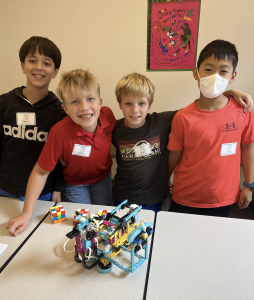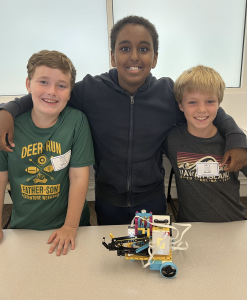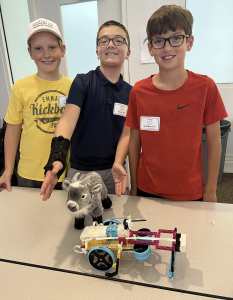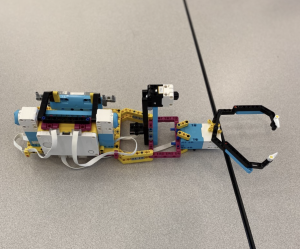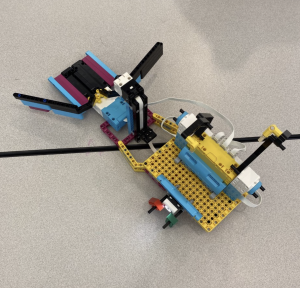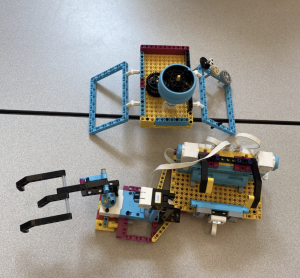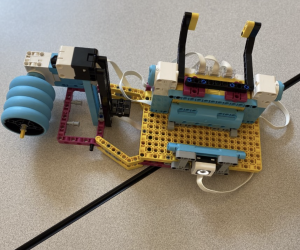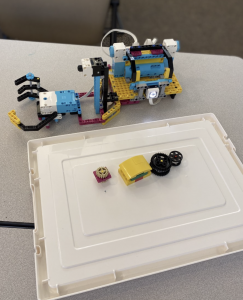Summer SAVY 2022/Session 6 – Robotic Engineering for Rising 5th/6th Grade
Friday: As a community, we discussed time management as not only a life skill but a group skill. We talked about ways to break up big projects and why having clearly defined roles and tasks is important, making sure there are checkpoints along the way, and when to ask for help. We also explored how to handle a project when everyone is interested in the same kind of work or, worse, there are tasks no one wants to complete. We talked about how compromise can help sort out the work and build consensus. These strategies were certainly put to the test today!
On our last day of camp, we had our “Invention Convention.” This was an opportunity for students to take everything they learned through the week and apply it to their prototype. Each company was challenged to plan, build, program, test, and iterate its prototype using the engineering design process. They were also asked to create a compelling sales presentation to pitch their inventions to potential “investors” (classmates).
What an impressive group of creations we had! But I would expect nothing less from this amazing group of creative thinkers. We had a GBC on wheels called “Portable Soccer Ball Factory,” a military-grade amphibious “Salamander,” a battle bot that was “The GOAT,” a new toy called the “Breakdancer Ultra Million,” and a cube solver called “Rubik’s Legend.” (Of special note, our two human competitors took down the bot every time!)
Ask your child to explain how they applied the engineering design process to create their final projects. How did they use their engineering notebooks throughout the week? (They brought it home today!) If they had time to make one more improvement to their final project, what would that have been? How did their team break up the work? In which areas did their team excel?
Several of our students asked me to send information about the LEGO Spike Prime kit and the instructions/code for the PrimeCuber (Rubik’s cube solver)
Robot Kit:
SPIKE Prime | Secondary School STEAM Learning | LEGO® Education
PrimeCuber instructions:
PrimeCuber for SPIKE Prime (mindcuber.com)
I hope our future leaders and innovators will take some of the tips and tricks learned this week and apply them to group work at school and beyond. It has been an absolute pleasure working with each of these students. Thank you for the privilege. Enjoy the rest of your summer!
Thursday: How do programmers deal with complicated code? Earlier this week we learned how programmers use shortcuts to condense long or repetitive bits of code. In the LEGO Education App this is called a MyBlock. We learned about adding inputs and variables into our MyBlocks, as well. We applied this strategy to our morning game called “Apple, Orange, Banana.” Students assigned a series of actions to each word: burpees for apple, jumping jack for orange, push-up for banana, and sit-up for grape (yeah, we added extra fruit.) We went around the circle twice and by our third circuit, students were able to remember the actions assigned to each word.
This morning our creative inventors continued work on their prosthetics. Some companies took inspiration from previous projects and made improvements, while others experimented with free builds. Several created claw-style hands by applying knowledge from yesterday’s build to create devices for a student, an engineer, a builder, and a butler. One team created a customized hand for a boxer. It was interesting to learn how each team programmed their devices in different ways utilizing the force and color sensors. During their presentations, colleagues were asked to share how they were able to break up the work, share their teamwork successes, and identify areas for improvement.
LEGO conventions are held all over the world every year. One of the most popular attractions is the GBC or Great Ball Contraption. After a week of hard work, this afternoon we built a GBC of our own. We would have liked more time to work on this project, but our days go by so quickly. Fortunately, we had one completed build (and one almost done) and were able to see the GBC in action and understand how it works.
Tomorrow we will need to make some big decisions within our workgroups. Dealing with disappointment can be tough, especially when our ideas are rejected. We discussed different ways of looking at the decision-making process and how we can frame our perspectives to lessen the disappointment.
We’ve had so much fun this week – it’s hard to believe tomorrow is our last day. We will hold an in-class “Invention Convention.” Students will have an opportunity to revisit and improve upon a previous project or create an entirely new build. Each company will choose its project and follow the engineering design process to see it to fruition. At the end of the day, each company will give a sales pitch to “investors” (classmates.)
- When trying on their team’s prosthetic device, one student proclaimed, “This makes my childhood dreams come true!”
- Several of our campers are interested in careers in biomedical engineering.
- We watched Swedish Folktronica band Wintergatan’s music machine video and many students are inspired to build their own machines. Check out their YouTube channel (wintergatan2000) for detailed videos about their design process.
Wednesday: We read some exciting news from the SAVY Business Journal (our classroom whiteboard) – there were some staffing changes! Several colleagues “accepted” positions with a new company! The purpose of this exercise was to expose each team to new colleagues and provide an opportunity to apply teamwork strategies to a new dynamic. As a class, we discussed ways to make new members feel valued, identify both our own strengths and others’ strengths, and ways to ensure every voice on the team is heard. We also discussed leading by example and being a good peer mentor.
Next, we continued work on our Computerized Numerical Control or CNC machines. Yesterday our companies went into the business of refurbishing broken machines for resale. This morning each team successfully identified and fixed the four mechanical problems: a missing paper feeder wheel, a top-to-base assembly issue, inverted feeder gears causing the paper to enter the machine too quickly, and a pencil carriage issue. Once the problems were solved students tested the CNC machine by drawing a square. We learned that the same motors with the same code produced different outcomes. We applied what we learned in yesterday’s professional development to calculate the gear ratio of the pencil carriage (6:11) and paper feeder (1:3) to better understand mechanical advantage. Students worked to perfect their code to draw perfect squares, then learned measurements had to be scaled in order to keep the square, well, square! This project was very popular and several of our campers wished for more time.
Can one size really fit all? Today we built a grabber device with a touch sensor trigger that included two variations: one for light, flexible objects and one for rigid, heavy objects. Each company designed its own criteria to evaluate the two devices then conducted experiments and recorded data in their engineering notebooks before taking on the role of a design engineer. The objective: improve the design to create a more versatile grabber. Teams created parameters, brainstormed ideas, and made a decision. They sketched ideas in their notebooks before setting to work. There were many iterations as students worked to test and redesign their grabbers. Finally, we talked about making compelling sales pitches. Companies named their products and wrote and presented an infomercial to the class. We were entertained by some incredibly fun presentations!
Bioengineering is an exciting and growing field. Today we learned how college students are 3D printing mechanical hands for children with disabilities. Tomorrow each company will delve into this noble work by designing a prosthetic robotic hand. This challenging project will provide a great opportunity to apply the engineering design process, teamwork strategies, prior knowledge, and creativity!
Wednesday’s Fun Facts
- Our morning ice-breaker was a game called “electric fence” and I’m pleased to report everyone made it through unscathed.
- We may not “talk about Bruno,” but we’ll sing about him! Just one of several spontaneous sing-alongs this week.
- There was some amazing teamwork happening in our classroom today!
Tuesday: We started off our day with a fun game that required attention to detail and quick thinking. If there was an imaginary ball league, our team would be contenders! We quickly reviewed yesterday’s lessons before jumping into today’s activities.
We continued our group work discussion. Today we talked about the importance of organizing and delegating work to ensure everyone has a role. We talked about what makes a good team moderator and the common mistakes leaders make. Finally, we talked about what to do when a team member isn’t paying attention or pulling their weight, strategies for working to engage them, and when it’s the right time to seek help from an adult.
Our first robot build of the day was a mechanical rhino for a “tech zoo” with a touch sensor. We explored inductive reasoning (bottom-up approach) and deductive reasoning (top-down). We also talked about repeatability and the importance of changing only one variable at a time. Students applied their geometry knowledge to calculate wheel circumference, then predicted (using inductive reasoning) which method would be more accurate: rotations, specified distance, or travel time. They conducted experiments and recorded data to test their hypothesis.
Our colleagues had professional development today. Our campers explored different types of gears and their uses, gear trains, and learned how to change the direction of motion using bevel gears. We also talked about mechanical gain, learned how to calculate gear ratios, and how to achieve more torque or speed.
Next, using a basic driving base, students learned how to set parameters (movement motors, movement speed, motor rotations), drive forward and backward, and how to use a gyro sensor to make accurate turns. We learned about pitch, roll and yaw, and how gyros are used in every day items from aerospace and automobiles, to mobile devices and steadicams, and even shawarma grills. Teams conducted experiments to determine the margin of error for each machine’s gyro sensor and made improvements until they were able to make a “perfect” square. Each group then pseudocoded and programmed the robot to travel in a shape of their choice.
This afternoon we learned about Computerized Numerical Control or CNC machines. Our companies went into the business of refurbishing broken machines for resale. Teams are working towards identifying the four mechanical problems of a build and making improvements. We will continue to work on this project tomorrow morning before setting to work to build a better grabber device and a prosthetic device.
Monday: Welcome to Robotics Engineering! It was such a pleasure meeting our talented community today. We are going to enjoy an amazing week together!
We started our day by getting to know one another through introductions. Students designed a personal crest and shared the significance of each element with the community. We learned we have many readers, musicians, athletes, LEGO enthusiasts, and gamers!
Students are often assigned group projects but are seldom taught the strategies necessary for success. Today we talked about evaluating decisions and learned to rank them (minor, moderate, and significant). As a class, we evaluated real-world scenarios/decisions, then talked about which merit discernment and which are best to decide quickly to keep projects moving. Rock-paper-scissors, anyone?
Our young professionals were grouped and asked to form a company and put these new decision-making strategies to work. Each start-up chose its company name, created a slogan, and designed a logo that incorporated at least one element from the founders’ personal crests. During their “grand opening,” each workgroup shared how they chose their name and what each founder contributed to the decision. Newly minted companies include Phoenix, The Readers, NFL, LEGO Pros, and The Wolves.
This week we will be using the LEGO Education App and LEGO SPIKE Prime robot kit for our hands-on activities. We completed a brief tutorial to become acquainted with the components: hub (“brain”); medium and large motors; and touch/force, color, ultrasonic, and gyro sensors.
Each company was tasked with a top-secret research and development project. Colleagues built a prototype of their new product using LEGO bricks and accessories and wrote assembly instructions. Instructions were passed to another team to test. Teams then presented their second builds and suggested improvements for their instructions. Our teams did an outstanding job! What did we learn from this exercise? Coding concepts: algorithm, bug, debug, decomposition, and pseudocode.
This afternoon our companies created a new toy: a music and story bot. Colleagues worked together to construct and code a robot equipped with a large motor and color sensor. As the robot spins it detects colors and plays an assigned sound. This fun project produced really creative results! Our stories ranged from sci-fi with “Alien Cat,” to drama with “The Band” and “Tragedy on Route 3,” to suspense with “The Door.” One of our teams told an “Among Us” story and even incorporated pictures on the hub’s light matrix!
Our day passed very quickly! We talked briefly about our activities for the week and introduced tomorrow’s first project: a mechanical rhinoceros for a tech zoo. We wrapped up our day by journaling in our engineering notebooks just a few minutes before dismissal. We look forward to another busy day tomorrow!
Monday’s Fun Facts:
- The most wished-for superpower in our classroom is invisibility with time travel in second. Our class was excited to engage in a spirited debate over the pros and cons of each proposed power, but sadly we had to table the discussion until lunch break.
- One of our students was born in Singapore and another’s family is from South Korea.
- A student offered this dating advice to classmates: “Wear red on dates. Girls like red.”
